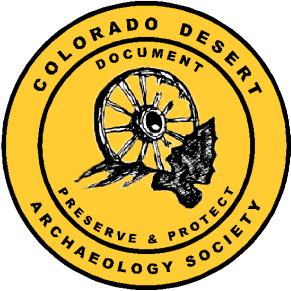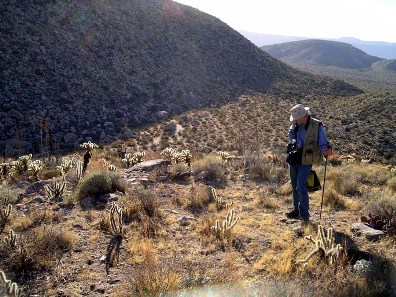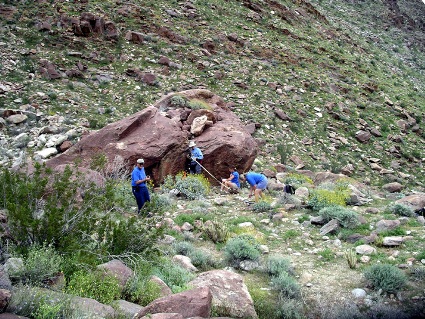Colorado Desert District Archaeological Site Stewardship Program

California State Parks promotes the importance of education about our common cultural and natural heritages and encourages public responsibility in the protection and preservation of cultural and natural resources on Park lands and elsewhere. This philosophy incorporates the training and use of volunteers to assist in and expand the roles of Park Staff in many endeavors.
Among the roles of volunteers is assistance in monitoring significant cultural resources that may be in danger of impacts from a variety of sources. Other government agencies such as the United States Forest Service (USFS) and the Bureau of Land Management (BLM) also have monitoring and/or stewardship programs. Monitors are usually interested members of the public who have a high degree of concern about the preservation and protection of cultural resources and who have some training in archaeology, history, and/or cultural resource management. This training may be formal or informal.
The Colorado Desert District (CDD) has joined forces with members of the Colorado Desert Archaeology Society (CDAS) and other volunteers to create a successful Archaeological Site Stewardship Program. The CDD includes three State Park units: Anza-Borrego Desert State Park, Cuyamaca Rancho State Park, and Palomar Mountain State Park. Site stewards visit archaeological sites in these parks on a regular basis to assess their condition. The stewards’ findings are then reported to the Park Rangers and District Archaeologists. The work of the stewards is invaluable and helps park staff to preserve and protect the sites from natural and human events that may cause harm to these important cultural resources.
FREQUENTLY ASKED QUESTIONS ABOUT ARCHAEOLOGICAL SITE STEWARDSHIP

WHAT IS ARCHAEOLOGICAL SITE STEWARDSHIP?
Archaeological Site Stewardship is a program of monitoring recorded prehistoric and historic sites on a regular basis. Monitoring includes obtaining baseline data on an initial visit with a professional archaeologist, regularly revisiting the site and making observations about various aspects of site condition, reporting findings to a designated agency staff member in a timely fashion after each visit, and immediately reporting any major impacts to the site that have occurred during the last monitoring visit. Archaeological Site Stewardship includes accepting a Code of Ethics and always acting on behalf of the protection and preservation of the cultural resource.
WHY DO ARCHAEOLOGICAL SITES NEED STEWARDSHIP?
There are a number of reasons why archaeological sites need stewardship. An uninformed public may purposefully, inadvertently, or unknowingly cause damage to fragile nonrenewable cultural resources. Vandalism is a huge cause of loss of cultural resources. It is not clear why certain people and groups purposefully damage archaeological sites, but many social, educational, and economic causes have been postulated. Accidents and inadvertent damages are usually due to a lack of understanding about the value of cultural resources, the importance of context, and the fact that once disturbed, cultural resources cannot be restored to their full value. Another important cause of compromise to archaeological sites is natural causes, such as water and wind erosion; erosion caused by foot, vehicle, and horse traffic; earth movement; and other forms of weathering and wear. While we often cannot prevent natural and human impacts to sites, sometimes we can prevent further damage and possibly control some of nature’s forces that cause the damage.
WHEN IS ARCHAEOLOGICAL SITE STEWARDSHIP IMPORTANT?
Archaeological Site Stewardship is important when the professional staff of public agencies is unable to periodically and systematically visit recorded archaeological and/or historic sites that are under their jurisdictions and that are subject to impacts. Limitations in agency staffing, funding, priorities, and physical access to remote areas are some of the reasons why Archaeological Site Stewards can make a significant contribution to our collective cultural heritage. Site Stewards can be the “eyes and ears” of professional staff and help preserve and protect cultural resources for future generations of scientists and the public.

WHO ARE ARCHAEOLOGICAL SITE STEWARDS?
Archaeological Site Stewards can be from any walk of life. They can be retired persons, working people, retired professional archaeologists, people who love the outdoors and hiking, horseback riding, or trail biking, college students, families who have an interest in regional prehistory and history, persons concerned with their own heritage or the cultural heritage of others, teachers, policemen – practically anyone. Site Stewards must be over 18 years old, be concerned about the protection and preservation of cultural resources, understand the Cultural Resources Laws, and be willing to adopt a Code of Ethics.
WHERE DO ARCHAEOLOGICAL SITE STEWARDS WORK?
Archaeological Site Stewards can work in State Parks, on Indian Reservations, on Forest Service lands, on BLM and Bureau of Reclamation Lands, or on private lands. Stewards can pick their own sites to monitor or be assigned a site or sites by professional staff of government agencies or non-profit preservation agencies.
HOW DO ARCHAEOLOGICAL SITE STEWARDS CARRY OUT THEIR DUTIES?
Archaeological Site Stewards carry out their monitoring activities independently after initial training and adoption of a Code of Ethics. They may set their own schedules, but agree to monitor a specific site or sites on a regular basis, recording their observations and reporting to a designated person, agency, or authority. Archaeological site stewards are not enforcers of the Cultural Resources laws. They do not enter into confrontational situations with the public. Archaeological Site Stewards understand and practice field safety procedures. They have observational skills and reporting skills. They identify themselves as Site Stewards to the public.
The tools needed to be a Site Steward:
• General knowledge of and interest in local and regional history and prehistory
• Understanding the cultural and natural landscapes
• Understanding Native American views of archaeological sites, Traditional Cultural Properties, and their visibility and use.
• A knowledge of State and Federal Cultural Resource Laws
• Willingness to embrace and operate under California State Parks, Society for California Archaeology, Society for American Archaeology, or other Code of Ethics regarding cultural resources
• Ability to commit to a regular schedule of observation and recording
• A mechanism whereby there is regular reporting to a responsible agency
• Knowledge of fieldwork safety practices
